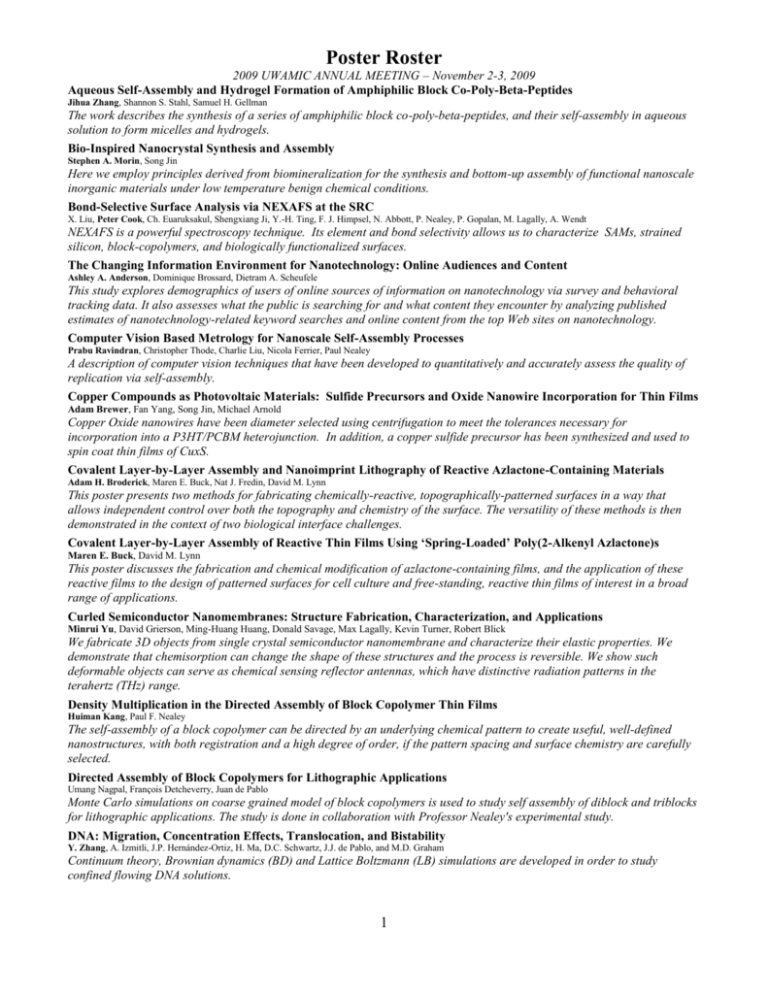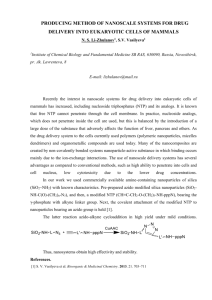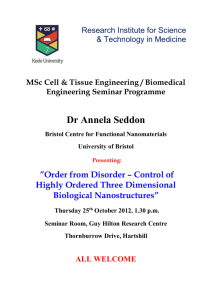- University of Wisconsin
advertisement

Poster Roster 2009 UWAMIC ANNUAL MEETING – November 2-3, 2009 Aqueous Self-Assembly and Hydrogel Formation of Amphiphilic Block Co-Poly-Beta-Peptides Jihua Zhang, Shannon S. Stahl, Samuel H. Gellman The work describes the synthesis of a series of amphiphilic block co-poly-beta-peptides, and their self-assembly in aqueous solution to form micelles and hydrogels. Bio-Inspired Nanocrystal Synthesis and Assembly Stephen A. Morin, Song Jin Here we employ principles derived from biomineralization for the synthesis and bottom-up assembly of functional nanoscale inorganic materials under low temperature benign chemical conditions. Bond-Selective Surface Analysis via NEXAFS at the SRC X. Liu, Peter Cook, Ch. Euaruksakul, Shengxiang Ji, Y.-H. Ting, F. J. Himpsel, N. Abbott, P. Nealey, P. Gopalan, M. Lagally, A. Wendt NEXAFS is a powerful spectroscopy technique. Its element and bond selectivity allows us to characterize SAMs, strained silicon, block-copolymers, and biologically functionalized surfaces. The Changing Information Environment for Nanotechnology: Online Audiences and Content Ashley A. Anderson, Dominique Brossard, Dietram A. Scheufele This study explores demographics of users of online sources of information on nanotechnology via survey and behavioral tracking data. It also assesses what the public is searching for and what content they encounter by analyzing published estimates of nanotechnology-related keyword searches and online content from the top Web sites on nanotechnology. Computer Vision Based Metrology for Nanoscale Self-Assembly Processes Prabu Ravindran, Christopher Thode, Charlie Liu, Nicola Ferrier, Paul Nealey A description of computer vision techniques that have been developed to quantitatively and accurately assess the quality of replication via self-assembly. Copper Compounds as Photovoltaic Materials: Sulfide Precursors and Oxide Nanowire Incorporation for Thin Films Adam Brewer, Fan Yang, Song Jin, Michael Arnold Copper Oxide nanowires have been diameter selected using centrifugation to meet the tolerances necessary for incorporation into a P3HT/PCBM heterojunction. In addition, a copper sulfide precursor has been synthesized and used to spin coat thin films of CuxS. Covalent Layer-by-Layer Assembly and Nanoimprint Lithography of Reactive Azlactone-Containing Materials Adam H. Broderick, Maren E. Buck, Nat J. Fredin, David M. Lynn This poster presents two methods for fabricating chemically-reactive, topographically-patterned surfaces in a way that allows independent control over both the topography and chemistry of the surface. The versatility of these methods is then demonstrated in the context of two biological interface challenges. Covalent Layer-by-Layer Assembly of Reactive Thin Films Using ‘Spring-Loaded’ Poly(2-Alkenyl Azlactone)s Maren E. Buck, David M. Lynn This poster discusses the fabrication and chemical modification of azlactone-containing films, and the application of these reactive films to the design of patterned surfaces for cell culture and free-standing, reactive thin films of interest in a broad range of applications. Curled Semiconductor Nanomembranes: Structure Fabrication, Characterization, and Applications Minrui Yu, David Grierson, Ming-Huang Huang, Donald Savage, Max Lagally, Kevin Turner, Robert Blick We fabricate 3D objects from single crystal semiconductor nanomembrane and characterize their elastic properties. We demonstrate that chemisorption can change the shape of these structures and the process is reversible. We show such deformable objects can serve as chemical sensing reflector antennas, which have distinctive radiation patterns in the terahertz (THz) range. Density Multiplication in the Directed Assembly of Block Copolymer Thin Films Huiman Kang, Paul F. Nealey The self-assembly of a block copolymer can be directed by an underlying chemical pattern to create useful, well-defined nanostructures, with both registration and a high degree of order, if the pattern spacing and surface chemistry are carefully selected. Directed Assembly of Block Copolymers for Lithographic Applications Umang Nagpal, François Detcheverry, Juan de Pablo Monte Carlo simulations on coarse grained model of block copolymers is used to study self assembly of diblock and triblocks for lithographic applications. The study is done in collaboration with Professor Nealey's experimental study. DNA: Migration, Concentration Effects, Translocation, and Bistability Y. Zhang, A. Izmitli, J.P. Hernández-Ortiz, H. Ma, D.C. Schwartz, J.J. de Pablo, and M.D. Graham Continuum theory, Brownian dynamics (BD) and Lattice Boltzmann (LB) simulations are developed in order to study confined flowing DNA solutions. 1 Poster Roster 2009 UWAMIC ANNUAL MEETING – November 2-3, 2009 Electrokinetic Characterization of Biomolecule Surface Adsorption Ruoban Han, Ryan Kershner This poster explains the adsorption phenomenon of DNA nano-structure (DNA origami) onto solid surface (mica and SiO2). The determinant of adsorbing is found to be electrokinetic surface charge density, which is calculable from zeta-potential. Engineering Aqueous-Liquid Crystal Interfaces with Macromolecular Amphiphiles Michael I. Kinsinger, Maren E. Buck, Bin Sun, David M. Lynn, Nicholas L. Abbott A general and versatile approach to tailor the properties of interfaces created between nematic liquid crystals and immiscible aqueous phases using multifunctional amphiphilic polymers. Environmental Health and Safety Impacts of Surface Functionalized Nanoparticles Kacie Louis, Ofek Bar-Ilan, Warren Heideman, Thomas Keuch, Andrew Mangham, Joel Pedersen, Richard Peterson, Paige Wiecinski, Robert Hamers CdSe quantum dots and TiO2 nanoparticles are synthesized and functionalized with various materials to improve functionality while hopefully reducing toxicity. For the TiO2 nanoparticles, reactive oxygen species produced in water under light are looked at as a possible source of toxicity. Full Wafer Block Copolymer Lithography for Developing Novel Semiconductor Structures Smita Jha, Chi-Chun Liu, J.H. Park, M. Wiedmann, T.S.Kuan, Susan E. Babcock, Paul F. Nealey, Luke J. Mawst, Thomas F. Kuech Block copolymer nanopatterns have been generated and used for defect reduction in lattice mismatched materials as well formation of quantum dot structures. Functionalization of ZnO Surfaces with Organic Molecules Guowen Peng, Peerasak Paoprasert, John Uhlrich, Rose Ruther, Paul Evans, Padma Gopalan, Robert Hamers, Thomas Kuech, Manos Mavrikakis Functionalization ZnO surfaces with organic molecules is of great interest. In this poster, we will present that ZnO surfaces can be functionalized with small organic molecules using different linkers. Genomic Analysis via Nanoconfinement: Nanocoding Kristy L. Kounovsky - Shafer, Juan de Pablo, David C. Schwartz Molecular confinement approaches offer new routes for presentation of biomolecules as ordered arrays that analysis of single molecules. This new approach avoids many of the potentiate the large-scale common pitfalls associated with surface modalities, and engenders novel nanoconfinement effects associated with large DNA molecules. Governing Principles of Beta-Peptide Self-Assembly Derek Ma Beta-peptides provide a unique opportunity to revolutionize nanotechnology; demonstrating potential to exceed the abilities of its alpha (natural) counterpart. Understanding the mechanisms of its self-assembly process is key to harnessing this potential. Grafting of Poly(3-hexylthiophene) Brushes on Oxides using Click Chemistry Peerasak Paoprasert, Josef W. Spalenka, Dane L. Peterson, Rose Ruther, Robert J. Hamers, Paul G. Evans, Padma Gopalan A versatile “grafting-to” approach using click chemistry can be used to prepare dense semiconducting poly(3hexylthiophene) (P3HT) brushes on oxide substrates including SiO2 and ZnO. \ Harnessing Protein Conformational Change to Control Drug Release from Dynamic Hydrogels William J. King, Michael W. Toepke, William L. Murphy The protein Calmodulin (CaM) undergoes a dynamic conformational change upon ligand binding. CaM has been incorporated into hydrogels to create materials that demonstrate a dynamic response when exposed to specific molecules; the dynamic response can be used in applications ranging from chemical sensing to drug delivery. The Information Seeking Environment for Science Online: How Google Shapes Information Context on Nano Issues Peter J. Ladwig, Ashley A. Anderson, Dominique Brossard, Dietram A. Scheufele Using data from Google data from October 2008 to 2009, we found that the Google search process and search results may be shaping the public perceptions of nanotechnology towards a health frame and away from an economic frame. Learning through Working Together: UW MRSEC Partners with the Nanoscale Informal Science Education Network O.M Castellini, D. Horoszewski, K.A. Duncan, T.J. Stefonek-Puccinelli, E. Hood, A. Johnson, K. Luster, D. Meshoulam, R. Nygard, J. Paguirigan, M. Sims, A. Vedder, H. Williamson, T. Dassler, G.C. Lisensky, W.C. Crone, G.M. Zenner The UW MRSEC has been a subawardee partner in the Nanoscale Informal Science Education Network (NISE Net) since the beginning of the NSF-funded Network. The NISE Net and UW MRSEC collaborate to increase public awareness of nanotechnology and to create a national network of education professionals and researchers knowledgeable about and skilled in public nanotechnology education. Mechanism of Ethylene Epoxidation on Gold Nanoclusters Yin Jin Lee, Guowen Peng Manos Mavrikakis Gold nanoclusters had shown exceptional catalytic properties for alkene epoxidation. The underlying microscopic mechanism of the ethylene epoxidation over gold nanocluster catalyst will be illustrated in this presentation. 2 Poster Roster 2009 UWAMIC ANNUAL MEETING – November 2-3, 2009 Modeling Liquid Crystalline Elastomers Raj Shekhar, Juan J. de Pablo A hierarchical modeling approach that includes both molecular and mesoscale representations of Liquid Crystalline Elastomers. Molecular Control of Photoinduced Charge Transfer from Organic Semiconductors to ZnO Josef W. Spalenka, Peerasak Paoprasert, Robert J. Hamers, Ryan Franking, Padma Gopalan, Paul G. Evans This work uses field-effect transistors as a tool to study charge transfer between an organic layer and ZnO nanoparticles. Modifying the surface of the ZnO nanoparticles with organic monolayers is found to have large effects on photoinduced charge transfer. Molecular Interfaces to ZnO Rose Ruther, Ryan Franking, Guowen Peng, Alex Huhn, Peerasak Paoprasert, Padma Gopalan, Manos Mavrikakis, Robert J Hamers The photochemical grafting of alkenes is explored as a new method for modifying the surface of zinc oxide. Negative Differential Resistance through Pentacene at Functionalized Electronic Interfaces Soonjoo Seo, Guowen Peng, Manos Mavrikakis, Rose Ruther, Robert J. Hamers, Paul G. Evans Room temperature negative differential resistance (NDR)has been measured in the tunneling spectra of pentacene thin films on modified Si (001) with nitrobenzene and styrene using scanning tunneling spectroscopy (STS). Negative Poisson's Ratio and Negative Stiffness in Barium Titanate Ceramic Liang Dong, Donald Stone, Roderic Lakes Negative Poisson's ratio and negative stiffness have been experimentally testified in barium titanate ceramic, which are considered as common mechanical responses of ferroelectric materials. Negative stiffness can be utilized to fabricate ultrastiff composite materials that even surpass diamond by orders of magnitude. A Novel Fabrication Method for Chemical Pattern Substrates and the Effect on Defect Density of Directed Assembly of Block Copolymers with Density Multiplication Chi-Chun Liu, Francois Detcheverry, Eungnak Han, Shengxiang Ji, Padma Gopalan, Juan J. de Pablo, Paul F. Nealey A novel fabrication method for chemical pattern substrates was proposed. We demonstrated that the control in chemistry and geometry of the chemical pattern is crucial to defect density of directed assembly of block copolymers with density multiplication. Observing Progressive Color Change through Growth of Silver Nanoprisms K. McElhinny, K.D. Cadwell, J. Eversage, S.M. Benitez, G.C. Lisensky, G.M. Zenner This laboratory experiment was designed to introduce students to nanotechnology and a unique nanoscale property, surface plasmon resonance. Students synthesize increasingly larger colloidal silver nanoprisms and estimate particle size using visible spectroscopy. Ordering and Dynamics in Liquid Crystal-Nanoparticle Systems Gary Koenig, Gaurav Pranami, Daniel Abras, Juan de Pablo, Nicholas Abbott Two methods to probe local ordering of liquid crystals near nanoparticle surfaces are described. The first method infers the local order from the mobilities of nanoparticles dispersed in a liquid crystal. The second method uses the optical properties of immobilized nanoparticles to probe the surrounding dielectric environment. Ordering Transitions in Micrometer-Sized Liquid Crystalline Emulsion Droplets Induced by Lipopolysacharides I-Hsin Lin, Christopher Murphy, Juan de Pablo, Nicholas L. Abbott This liquid crystal-based Lipopolysaccharide detection method demonstrates that liquid crystal anchoring transition can be used to report the Lipopolysaccharide presence. In addition, this novel method does not require biologically-derived reagents and it has a sensitivity comparable to the commercial/clinical LAL assay at pg/ml concentration range. Patterning Multiple DNA Sequences at Nanoscale M. Serdar Onses, Franco Cerrina, Paul F. Nealey Here we demonstrate a sequential deposition approach for patterning multiple sequences at nanoscale with spatial control. Photo-activated Titanium Dioxide Nanoparticles Induce Toxicity Through an Oxidative Stress Mechanism in Zebrafish Embryos Ofek Bar-Ilan, Kacie Louis, Sarah Yang, Robert Hamers, Joel Pedersen, Richard Peterson, Warren Heideman Shorter-wavelength light reaching Earth’s surface has sufficient energy to generate separated electrons and holes in titanium dioxide nanoparticles, and when these electron-hole pairs do not recombine and instead interact with water or molecular oxygen, reactive oxygen species (ROS) are formed. Oxidative conditions in vivo, where ROS outnumber their neutralizing antioxidant counterparts, result in ROS indiscriminately damaging cellular macromolecules, leading to cellular death. We used zebrafish embryos to investigate possible toxicological implications of titanium dioxide nanoparticle photochemistry on development and we hypothesized that photo-activated titanium dioxide nanoparticles induce oxidative toxicity in zebrafish embryos. 3 Poster Roster 2009 UWAMIC ANNUAL MEETING – November 2-3, 2009 Size and Interface Dependent Ordering of Liquid Crystals in Microdroplets Jugal Gupta, Rebecca Carlton, Juan de Pablo, Frank Caruso, Nicholas Abbott We describe the preparation of polymeric capsules by a template-based synthesis method that employs monodisperse silica spheres, and the filling of these capsules with a nematic liquid crystals (LCs), thus forming polymer-coated LC droplets. This approach provides a level of control over size and interface-dependent ordering of LC droplets that has not been possible in the past, and will enable size-dependent properties of LC droplets to be exploited in applications such as photonics and sensing. Structured Interfaces with Tunable Adhesion Hyun-Joon Kim-Lee, Yun Liu, Izabela Szlufarska, Kevin T. Turner Structuring of interfaces can have a dramatic effect on the adhesion. In this work, the fundamental role of geometry in interfacial adhesion is investigated by atomistic simulations, numerical and analytical modeling, and experimental measurement. Surface Tension Measurements in Polymer Melts by Vacuum Tensiometer Mikhail Y. Efremov, Paul F. Nealey Tensiometer designed for measurements of surface tension in viscous liquid polymers in 20 - 300 oC temperature range under clean vacuum conditions is described. First results of testing polystyrene melts are given. Theoretical Characterization of Block Copolymer Melts Darin Pike, François Detcheverry, Marcus Müller, Paul Nealey, Juan de Pablo Coarse-grained Monte Carlo simulations are used to discover properties of block copolymer melts, including density profiles, phase boundaries, and the local stress. Thickness Dependence of Glass Transition in Polymer Coatings Observed by Temperature-Modulated Ellipsometry in Vacuum Mikhail Y. Efremov, Shauheen S. Soofi, Anna V. Kiyanova, Claudio J. Munoz, Franco Cerrina, Paul F. Nealey Spectroscopic ellipsometry in vacuum, its novel temperature-modulation modification, and application of these techniques for probing glass transition in 2 - 100 nm thick polystyrene and PMMA coatings are discussed. Ultrafast Charge Transfer at the Organic/Inorganic Interface Wei Xiong, Jennifer Laaser, Peerasak Paoprasert, Ryan Franking, Rose Ruther, Jordan Schmidt, Padma Gopalan, Robert Hamers, Martin Zanni We report a series of ultrafast spectroscopic studies of dyes bound to TiO2 nanocrystalline thin films. Transient IR absorption measurements reveal electron-injection kinetics and yields that are strongly dependent on the nature of the dye linker. Transient 2DIR spectra reveal that dyes bind to the surface in multiple conformations and enable us to measure the kinetics of these different conformations independently, providing a clue to the molecular-level origin of the observed multiexponential kinetics and bringing an unprecedented level of insight into charge-transfer dynamics in these systems. Understanding the Impact of Chemical Patterns on the Interactions and Self-Assembly of Organic Nanostructures Claribel Acevedo-Vélez, William C. Pomerantz, Juan J. de Pablo, Samuel H. Gellman, Nicholas L. Abbott We describe an investigation of the interactions of organic nanostructures formed from non-natural β-amino acids (βpeptides) at interfaces. Specifically, the impact of nanoscopic chemical patterns on forces generated between β-peptide-based nanostructures and model surfaces has been investigated by using AFM single-molecule force spectroscopy. University of Wisconsin–Madison Nanoscale Science and Engineering Center Education and Outreach Mary E. Anzovino, Brittland K. DeKorver, Andrew E. Greenberg, John W. Moore A summary of ongoing projects in the education and outreach division of the NSEC. 4






